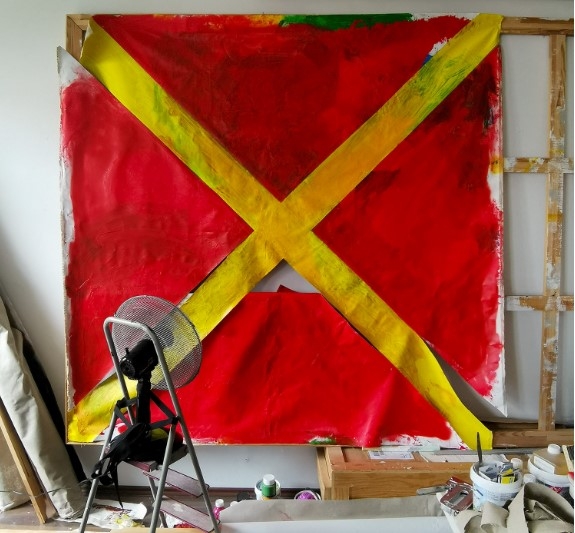The title Better Shelter is taken from Ikea’s name for the modular houses that are delivered in flat packaging to crisis-affected areas around the world. Fabra Guemberena lends the name to an installation where the contents of the Ikea packaging have been removed and the cartons turned into abstract paintings.
The artwork relates both to the artist’s personal history and a larger discussion about the country Sweden. Fabra Guemberena and his family themselves arrived at the Moheda refugee camp in Småland in the late 1970s. The family was on the run from the military dictatorship in Uruguay and soon the temporary Småland barracks with their worn Ikea furniture became a temporary “home”. Fabra Guemberena has used the experiences of the refugee camp as a kind of hub for a number of artistic strategies. During the research, he found the study “The Global Shelter Imaginary” from a university in Minnesota. The study drives the thesis that Ikea’s design solution response to the refugee’s situation in a way locks in the ideas about escape and the refugee’s complex life drama. The improvement of the refugee’s temporary physical protection focuses on the refugee as the project itself – “you can simply become a better refugee”, to quote Juan-Pedro Fabra Guemberena himself.
The installation Better Shelter is currently being shown in Sweden in two different versions at two different institutions at the same time. Among some of Sweden’s most famous modernist paintings in the exhibition “A Home” at Thielska Gallery and in Fabra Guemberena’s solo exhibition in Södertälje Art Gallery. The effect of the work is striking and has different types of effects in the two exhibitions. At Thielska Galleriet, it is as if the installation Better Shelter for a direct and triumphant dialogue with the Nordic (art) history, it takes place with simple materials and sensual, clear colors close to colleagues Eugène Jansson and Edvard Munch. In Södertälje Art Gallery, the reflections on the artwork are of a different nature and the questions that linger are darker. Better Shelter encourages us to reflect on what is difficult, on what is hidden. In this way, Juan-Pedro Fabra Guemberena inverts “help” as a concept. Here it is we as viewers who get an opportunity to see more clearly. The artist thus joins a canon of artists who in different ways create conditions for the viewer to sharpen their gaze both inwards and in relation to the surrounding society – at the same time.
Joanna Sandell, director of Södertälje Art Gallery




